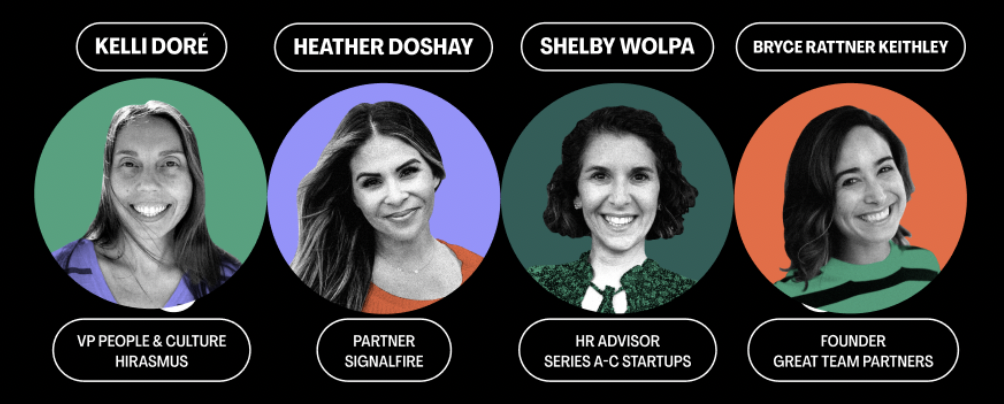
Being appointed as your company's first head of people is both exciting and horrifying. You're not just filling an HR role—you're the founder of the employee-experience product your company "sells" to current and future talent. Whether you're a founder taking on the head of people role, an operations leader expanding your scope, or an experienced people-professional with the opportunity to build the people function, the role can be daunting.
Where do you start? What and how (or, who) should you prioritize? How do navigate onboarding you are likely designing yourself, and how do you reduce the risk of costly mistakes as much as possible?
This is the first of a 5-part series designed specifically for first-time "Head of People", leaders. Over the next few posts, we'll provide you with battle-tested frameworks, templates, exposure to the common unknown-unknowns, and support systems that actually work—you'll gain these insights from leaders who've successfully built people functions at companies which have earned unicorn-status.
Part 1: Strategic roadmap for your first 90 days
Part 2: Tactical action plans and templates (to execute your roadmap)
Part 3: Unknown-unknowns, pitfalls to avoid, and recovering from failures
Part 4: Designing a people infrastructure that scales with growth
Part 5: Establishing your HR community as a support system
We're drawing on the experience of four people-leader veterans. These four women have started from scratch as a first Head of People, multiple times. They've seen zero-to-scale at some of the most prolific brands around (Webflow, InVision, InstaCart, Square, Hired...) and they are here to share their unknown-unknowns, advice for a successful start, and how to navigate the challenges of working with new leaders, new cultures and new expectations.

Kelli Doré is a results-driven senior leader with a passion for transforming organizations through strategic leadership, inclusive cultures, and talent optimization. With over 20 years of experience in business operations across for-profit and nonprofit sectors, she is committed to driving sustainable growth while fostering belonging and collaboration. An advocate for diversity, equity, and environmental stewardship, Kelli brings a unique perspective to human resources, ensuring organizations thrive by empowering people and creating meaningful impact.
Heather Doshay is a Partner at SignalFire, an early-stage venture capital fund that offers startup founders less talk, and more value. Prior to SignalFire, Heather held roles such as VP People at Webflow and Rainforest QA, led Candidate Marketplace at Hired, and taught Organizational Leadership at the University of San Francisco. She is SHRM senior certified, serves on the PeopleTech Partners Advisory, and has served on the Forbes HR Council. She was honored as a top Talent Operator on the 2020 Anchor List and Top Women Leader in SaaS in the 2018 SaaS Report. You can find her work published in Entrepreneur, Forbes, Thrive Global, and VentureBeat.
Shelby Wolpa has been a People Leader at four companies that she's scaled to unicorn+ status: Palantir, One Medical, Instacart, and InVision. Shelby built and led these people teams through hypergrowth. She advises CEOs, People Leaders, and Venture Capital Firms to bring those learnings to Series A-C startups around the world. Shelby is a Pando advisor.
Bryce Rattner Keithley Is a Talent and People leader with experience at top venture-backed and publicly-traded companies (like Nextdoor and Square). At Great Team Partners she works with Founders of early-stage companies to help them get the People-stuff right from their very earliest days.
Every people leader needs to have deep empathy and understanding for their organization's past, pains and where its headed. It's important to "pick your battles" and understand what really needs a push and what can wait. Lots of new leaders want to come in a shake things up, but understanding where everyone's at is step one.
Here are three foundational strategies that can set you gain the context needed to create successful programs, products and solutions that lead to impact for your company.
Kelli Doré recently joined HiRasmus as VP of People and Culture, she advocates for every new leader to do a "listening tour": "The first thing I did was meet with the executive team and understand what their goals are, what they're looking for, what their pain points at this stage in the organization, and then...I met with every single team member."
This bottom-up and top-down approach–understanding both leadership vision and employee reality—creates the foundation for everything that follows. Kelli can leverage her learnings directly to justify solutions she'll propose; "I can reflect back those stories [creating a clear narrative] to justify the roadmap and plan."
When on your listening tour, consider yourself a product manager. "I think of the role of head of people as a product manager of the employee experience" says Heather Doshay. This perspective transforms how you approach those first 90 days—you're conducting user research, not just getting to know people.
If you're at a small company meeting with every person at the company can work, but the bigger the company the more focus is required. "It's important to get really clear about who you'll talk to" and communicating to the org what your plan is and how you plan to conduct this research and listening tour is key to getting pre-buy-in from folks you'll need support from later, as well as ensuring everyone feels heard even if you didn't talk to them.
Think about employee segments like personas and develop a list of questions for each group to understand their pain points today, and where those land in the employee lifecylce.
Before you can build, you need to understand what already exists. As Heather discovered: "Founders will tell you what they think they need. Once they told me "we just need to start sourcing more"...when I started I was like, great let's build our sourcing engine, you said you have greenhouse for your ATS, where is it? "Well, we didn't build it yet.""
You'll need to discover for yourself what is in place and what isn't, what has been done and what hasn't, who is invested (or has been) in people, or culture, what processes are actually in place, what tools and systems are being used, etc.
Your audit should cover three key areas:
Our unicorn whisperers have been "the first" several times, and all in different contexts, companies, industries, locations and with different founders and executive teams. Here are three pieces of advice to think about when new to the role:
There are people that care about people-related thing whether they are in the people team or now. "When I joined Webflow, 4 people messaged me on my 1st day just across the company, all saying, I'm so excited you're here. I've been wanting to talk about wellness programs" said Heather. These are champions and people that will support, advocate and champion they work you're doing–find them and nurture those relationships.
These champions are particularly important when it comes to implementing any plan, program or technology. They should be your "customer advisory board". They're often the most vocal critics if you miss their needs, but they become your strongest advocates when you include them in the solution.
Pro tip: Champions aren't always the obvious people. Look for those who've created their own solutions to people problems, who others turn to for advice, or who volunteer for cross-functional projects. They understand the real challenges and can help you design solutions that actually work
Shelby Wolpa, who's advised startups for five years after four head of people roles, wants to warn of a critical mistake: Going Dark. She shared a story where she made this mistake herself, "the company would said, hey, we need to implement this system... and so, I would go, for about 6 months, work really really hard on a solution (implementation)... and come back 6 months later "Tada, here it is"... and everyone would say, What is this? We didn't ask for this." She went dark.
Stakeholders need to be engaged throughout the process. While this pattern emerges from good intentions—you want to deliver something complete and polished, six months in a startup is an eternity. Priorities shift, teams change, and what seemed urgent becomes irrelevant. Regular check-ins, rapid-prototyping solutions, and iteration can prevent this costly mistake gives you the opportunity to shift gears if need be to adapt to changing demands of the business.
Perhaps the most challenging aspect of those first 90 days is saying no. As Shelby puts it, "Everything gets dumped on you–if it's not a clear marketing problem or a product problem or an engineering problem. It must be a people problem."
In your first month, you should already be crystal clear about what the main priorities are for the business and generally what they are for your new function. Rather than trying to do it all, get good at saying "no" and make sure you have 3-4 things you're focused on (per quarter) which are aligned to business goals.
You don't want to be inflexible—you want to be strategic. When you try to solve every problem immediately, you solve none of them well. Better to have three systems that work beautifully than ten that frustrate everyone.
There's always so much to cover to ensure you're focused on the right things, not to mention the fires that inevitably pop up and need to be addressed. To give yourself some structure while leaving room for ad-hoc and the reactionary work that will 100% crop up, try this timeline:
Remember: your first 90 days aren't about implementing everything. They're about understanding everything, building relationships, and creating a foundation for sustainable growth.
This comprehensive series will take you from day one through building a scalable people function:
Part 2: Tactical Action Plans and Templates for 0-90 Days - Detailed week-by-week action plans, interview templates, audit frameworks, and priority-setting tools you can implement immediately.
Part 3: Avoiding Critical Mistakes or Recovering from Them - The six most common mistakes first-time people leaders make, why they happen, and proven strategies for recovery when you inevitably stumble.
Part 4: Designing Infrastructure That Scales with Growth - The foundational systems every growing company needs: headcount planning frameworks, leveling structures, compensation strategies, and hiring processes that scale from 50 to 500+ employees.
Part 5: Establishing Your Community as a Support System - Professional communities, vendor relationships, AI tools, and external expertise that will accelerate your learning and make you more effective from day one.
Building a people function isn't just about implementing best practices—it's about creating the conditions where people can do their best work while your company achieves its ambitious goals. Our experts have learned these lessons through trial, error, and eventual success, so you can learn from their experience rather than repeating their mistakes.
Pre-Start Preparation:
Week 1-2 Priorities:
Foundation for Success:
The journey of building a people function is challenging, but with the right approach and mindset, it's also incredibly rewarding. You're not just implementing programs—you're shaping how people experience work at your company. That's a responsibility worth taking seriously–a challenge worth rising to meet.
Stay tuned for Part 2: Tactical Action Plans and Templates for 0-90 Days next week!
Pando is the first of its kind employee progression platform. We help organizations build continuous performance programs to drive high performing teams. Pando helps companies design and develop leveling, career frameworks and lightweight performance programs that drive results. Learn more at pando.com.